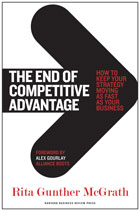 The opening lines lay out Professor McGrath's argument.
"Strategy is stuck," she tells us. If you dropped into a boardroom discussion, "...chances are you'd hear a lot of strategic thinking based on ideas and frameworks designed in, and for, a different era..."
So much for those CEOs being cutting edge! But it's not really their fault.
"Virtually all strategy frameworks and tools in use today are based on a single dominant idea: that the purpose of strategy is to achieve a sustainable competitive advantage. This idea is strategy's most fundamental concept. It's every company's holy grail. And it's no longer relevant for more and more companies."
Professor McGrath accepts that some industries may still be able to support sustainable advantages - making an airplane for instance, or running a mine - and so they still exist for some companies. but... "More and more sectors [such as] music, high technology, travel, communication, consumer electronics, the automobile business, and even education are facing situations in which advantages are copied quickly, technology changes, or customers seek other alternatives and things move on."
Faced with such uncertainties, "the presumption of stability creates all the wrong reflexes. It allows for inertia and power to build up along the lines of an existing business model. It allows people to fall into routines and habits of mind. It creates the conditions for turf wars and organizational rigidity. It inhibits innovation."
As you'd expect, Professor McGrath has plenty of examples of companies that got it wrong (Sony, Kodak, Nokia) and those who got it right (Fuji, Accenture, and her "Growth Outliers" which includes Infosys, Yahoo Japan, Tsingtao Brewery and Cognizant). There are some great stories here, including a personal twist on the oft-told Kodak failure, and a really great study of Alcoa which somehow manages to bring in the "Miracle on the Hudson". You even get to hear how Tumi luggage is "continually refreshing the points of value its products offer by anticipating what business travellers are going to need next."
The book argues that Porter's Five Forces Analysis is redundant as competition comes not just from cheap substitutes (the Clayton Christensen model of Disruptive Innovation) but from a change in perception in the wider marketplace that can leave knowledgeable insiders strggling to keep up.
"There I was in a frozen hotel in Oulu, Finland, with a bunch of Nokia engineers. The subject of the iPod came up. The reaction was entirely dismissive. 'That?' they said. 'It's just a hard drive built on older technology in a fancy case.'"
The remedy for mistakes such as this is for businesses to evolve a new strategy, and the chapters of the book summarise it well:
The opening lines lay out Professor McGrath's argument.
"Strategy is stuck," she tells us. If you dropped into a boardroom discussion, "...chances are you'd hear a lot of strategic thinking based on ideas and frameworks designed in, and for, a different era..."
So much for those CEOs being cutting edge! But it's not really their fault.
"Virtually all strategy frameworks and tools in use today are based on a single dominant idea: that the purpose of strategy is to achieve a sustainable competitive advantage. This idea is strategy's most fundamental concept. It's every company's holy grail. And it's no longer relevant for more and more companies."
Professor McGrath accepts that some industries may still be able to support sustainable advantages - making an airplane for instance, or running a mine - and so they still exist for some companies. but... "More and more sectors [such as] music, high technology, travel, communication, consumer electronics, the automobile business, and even education are facing situations in which advantages are copied quickly, technology changes, or customers seek other alternatives and things move on."
Faced with such uncertainties, "the presumption of stability creates all the wrong reflexes. It allows for inertia and power to build up along the lines of an existing business model. It allows people to fall into routines and habits of mind. It creates the conditions for turf wars and organizational rigidity. It inhibits innovation."
As you'd expect, Professor McGrath has plenty of examples of companies that got it wrong (Sony, Kodak, Nokia) and those who got it right (Fuji, Accenture, and her "Growth Outliers" which includes Infosys, Yahoo Japan, Tsingtao Brewery and Cognizant). There are some great stories here, including a personal twist on the oft-told Kodak failure, and a really great study of Alcoa which somehow manages to bring in the "Miracle on the Hudson". You even get to hear how Tumi luggage is "continually refreshing the points of value its products offer by anticipating what business travellers are going to need next."
The book argues that Porter's Five Forces Analysis is redundant as competition comes not just from cheap substitutes (the Clayton Christensen model of Disruptive Innovation) but from a change in perception in the wider marketplace that can leave knowledgeable insiders strggling to keep up.
"There I was in a frozen hotel in Oulu, Finland, with a bunch of Nokia engineers. The subject of the iPod came up. The reaction was entirely dismissive. 'That?' they said. 'It's just a hard drive built on older technology in a fancy case.'"
The remedy for mistakes such as this is for businesses to evolve a new strategy, and the chapters of the book summarise it well:
- Continuous reconfiguration (Chapter 2)
- Healthy Disengagement (Chapter 3)
- Using Resource Allocation to promote deftness (Chapter 4)
- Building an innovation proficiency (Chapter 5)
- Leadership and mid-set (Chapter 6)
- Personal meaning of transient advantage (Chapter 7)








